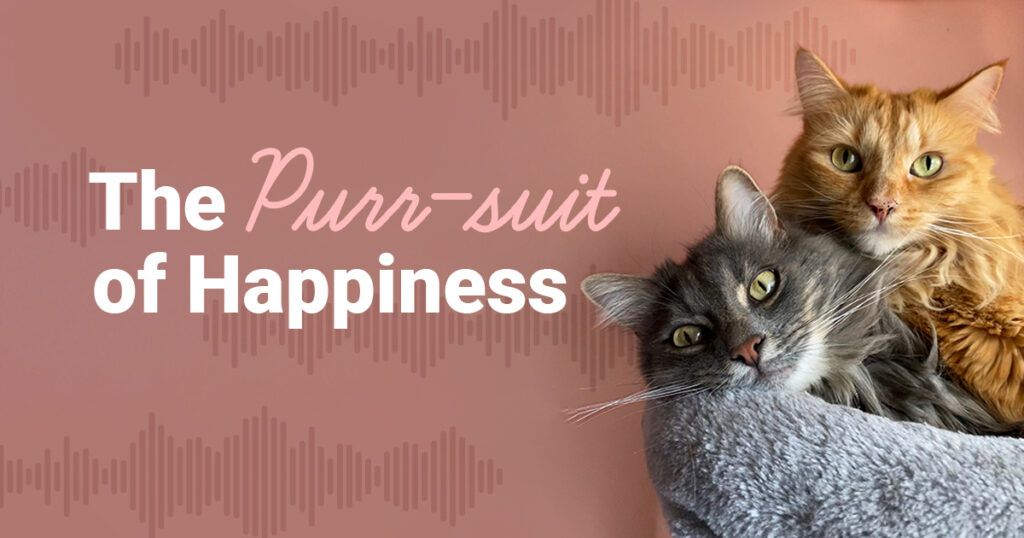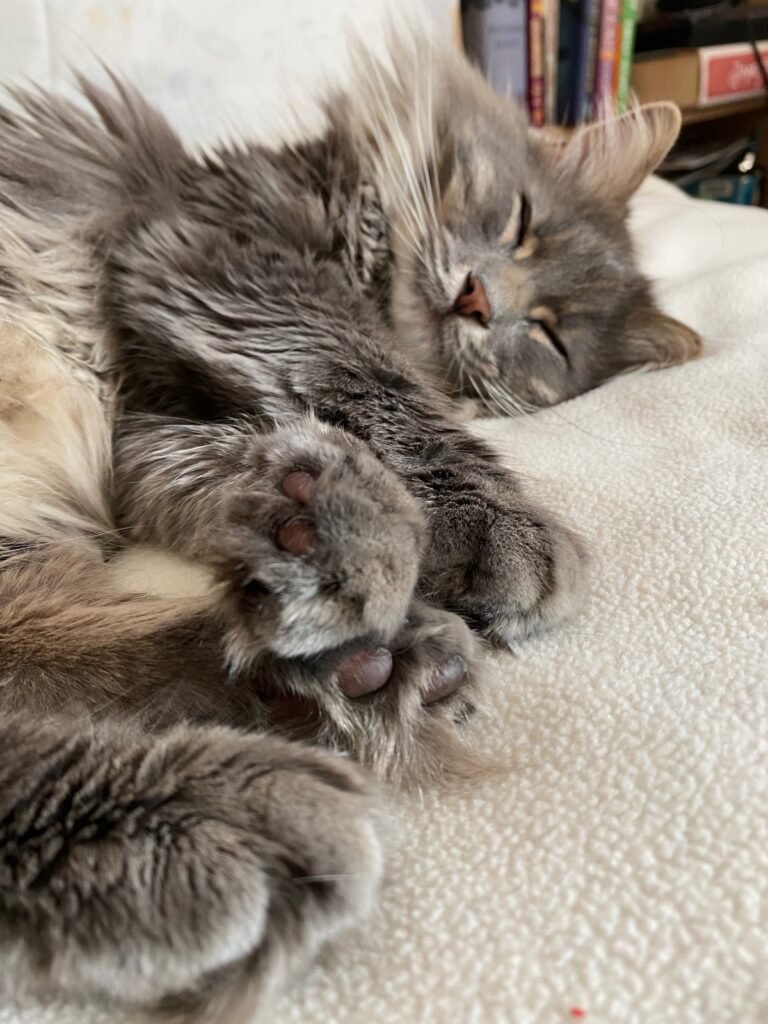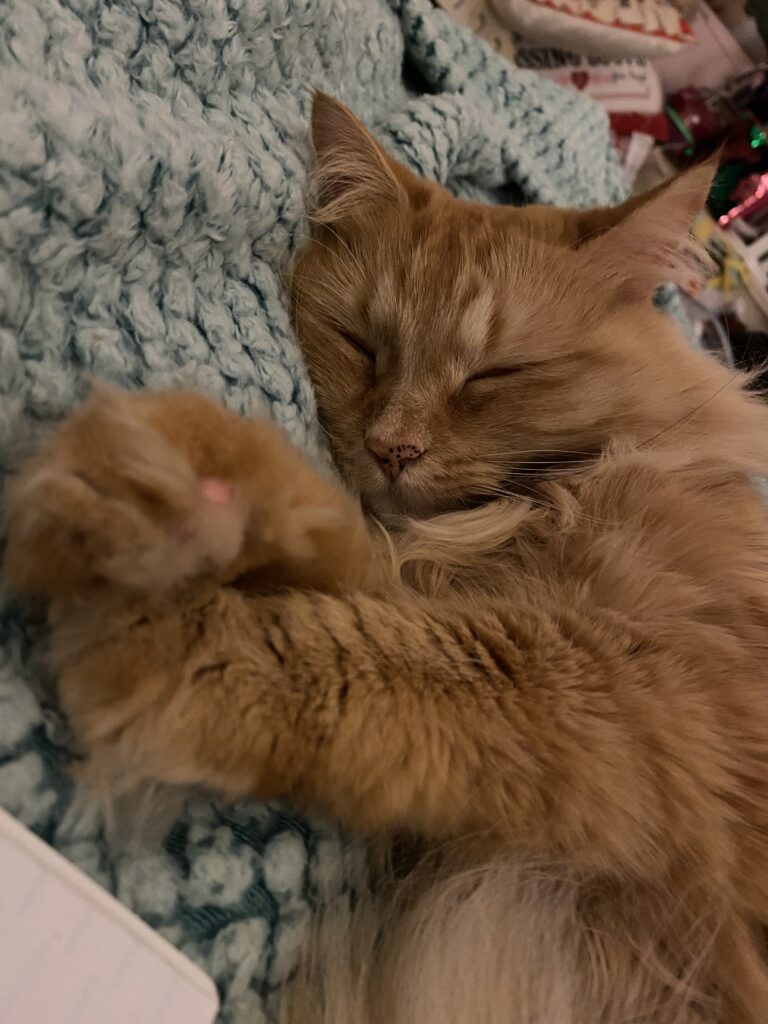As any cat person would tell you, one of the greatest joys in life is to be curled up with a feline friend as they purr. Though purring is one of the most widely recognizable and comforting sounds in the animal kingdom—a sound that has come to be virtually synonymous with coziness and contentment—the how and why behind it is still shrouded with some mystery.

Vocal Purr-duction
The scientific community defines purring as a “low-pitched regular sound produced during alternating (pulmonic) egressive and ingressive airstream”. This is a fancy way of saying that sound is continuously produced during both exhales and inhales with no interruptions in between, while keeping their mouths entirely closed. Like fuzzy little ventriloquists.
But how does purring actually work? In the 1960s, it was initially hypothesized that purring was the resulting sound of blood percolating through the inferior vena cava, the blood vessel that returns blood from the body to the heart. However, further research later disproved that theory, indicating that the purring mechanism involves communication between a neural oscillator deep in the feline brain and the larynx, or voice box. As a cat’s laryngeal muscles move, they constrict and dilate the glottis, the part of the larynx surrounding the vocal chords. During inhalation and exhalation, the air passing through the glottis vibrates, resulting in a purr.
Fun Fact: Purring isn’t limited to just domestic house cats! Several wild feline species like bobcats and mountain lions, plus their close relatives mongooses, genets and civets can all purr. But there are a number of other animals that can produce a purr that might surprise you, including rabbits, raccoons, bats, guinea pigs, gorillas and elephants!
Good Vibrations?

Though there is general consensus in the scientific community on the purring process, the question of exactly why cats purr is still up for debate, as studies regarding cat behavior and communication considerably lags behind the efforts for studying dogs. This may be partially due to the fact that dogs are typically more willing study participants (in that they are likely more easily bribed).
Though we most commonly consider a purring cat to be a contented cat, that is not always the case. It turns out that there are actually a number of other emotions and situations that will elicit purring as a response.
Cats first begin to purr when they are only a few days old. As newborn kittens are blind, deaf and overall completely helpless for the first few weeks of their lives, purring serves as a quiet, subtle form of communication and bonding mechanism between mother and offspring. Purring can help kittens communicate their location, and provides a means for mom to affirm her babies’ comfort and safety, as well as signal feeding times.
This behavior sometimes carries over into adulthood, with some cats continuing to purr while they eat or as a means to convince their human that it’s dinner time. A University of Sussex study found that cats even have a solicitous purr that they can employ for exactly this purpose. By embedding a cry similar in frequency to that of a human infant’s cry within a purr, cats can manipulate their owners into taking action and feeding them by triggering and exploiting their innate human nurturing instincts. Even the study participants with no cat experience could hear the difference in urgency between an ordinary and an “I’m hungry” purr.
Purring has also been hypothesized to be a sort of self-soothing mechanism, as cats have been observed to purr in response to nervousness, fear or stressful events, like a trip to the vet, being chased by a dog, or exploring a new environment. Cats have also been observed to purr when they are in pain and dying, leading researchers to postulate about purring’s potential healing properties—for cats and perhaps for humans as well.
Feline Fine
In the early 2000s, researchers dug further into this notion, proposing that purring may have palliative properties that may assist in accelerating the healing process for a cat’s wounds or broken bones.
Given that healers have employed the power of sound and vibrations in their work for centuries, the basis for this notion is not far-fetched. Various studies regarding sound frequencies have demonstrated promising vibratory therapy results in some animals, such as rabbits. Even NASA has explored this therapeutic avenue as a potential means to combat bone density loss and muscle atrophy in astronauts headed to space for long stints.
A 2001 study that recorded and measured the purrs of 44 felids including ocelots, servals, cheetahs, pumas and domestic cats, found that every individual in this study produced strong frequencies between 25 and 150 Hertz (Hz). They discovered that all the species except cheetahs produced frequencies at exactly 25 Hz and 50 Hz, which research suggests are the best frequencies to promote fracture healing and bone growth. Additionally, those same four felids have a strong harmonic either at or within 2 Hz of 100 Hz, a frequency that has been therapeutically used to treat wounds, dyspnea, edema and pain. These findings support the hypothesis that purring may be an advantageous, low energy mechanism that can stimulate feline muscles and bones while sedentary.
Purring releases endorphins in cats and can do the same in people. Endorphins can lower stress hormones, which is beneficial for healing, lowering blood pressure and overall stress, and helping people cope with illness.

Further studies have shown cat ownership in general has demonstrated some physical health benefits. In 2009, a 20 year study of over 4,000 people found that cat owners appeared much less likely to die of a heart attack or stroke, as opposed to people who have never known the love of a cat, with non-cat owners being 40% more likely to die of a heart attack and 30% more likely to die of another cardiovascular disease including strokes than cat owners. Another study by Australia’s Baker Medical Research Institute found that pet owners tend to have lower blood pressure than people who don’t have pets.
Though no research efforts have further explored the direct effects of using purring felines themselves as a mechanism for healing, the overall health effects cat ownership has on people is undeniable. And though the exact purpose and potential physical benefits still elude researchers, purring undoubtedly offers both a soothing psychological balm and gentle medium of communication between a cat and their people.
Sources:
- King, I. (2022) The Cat’s Purr: A Biomechanical Healing Mechanism? Accessed December 2022.
- Wu, K. (2022) Purring is a Love Language No Human Can Speak. The Atlantic. Accessed December 2022.
- Harris, R. Do People Who Own Cats Really Live Longer? Accessed December 2022.
- Qureshi, A., Memon, M., Vazquez, G. and Suri, M. (2009). Cat ownership and the Risk of Fatal Cardiovascular Diseases. Results from the Second National Health and Nutrition Examination Study Mortality Follow-up Study. Retrieved from www.ncbi.nlm.nih.gov.
- von Muggenthaler, E. (2001). The felid purr: A healing mechanism? The Journal of the Acoustical Society of America. 110(5):2666.
- Why and how do cats purr? Library of Congress. Accessed December 2022.
- Dowling, S. (2018) The complicated truth about a cat’s purr. BBC.com. Accessed December 2022.

One thoughtful comment